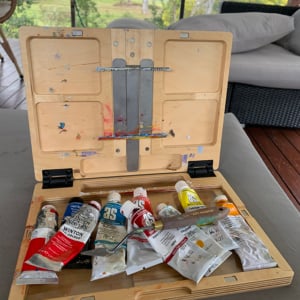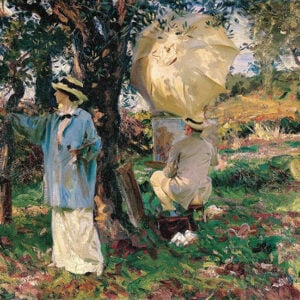
I recently had prints created for a handful of my paintings. It was a tricky process, but I’m pleased with the outcome. The prints are near-perfect representations of the originals. I’m sharing my experience in case you are interested in having prints created for your own artworks.
I’ll cover:
- Why Prints?
- Finding a Local Printer
- Photographing Your Art
- Print Type
- Shipping Your Prints
- Flattening Your Prints
- Framing Your Prints
- Selling Your Prints
- Other Ideas for Using Prints
- Other Resources
- Want to Learn More?
- Thanks for Reading!
Why Prints?

Prints are not a substitute for the original artwork, but they can extend their value and reach. Here are some of the key benefits:
- They provide your fans with a more affordable alternative to originals.
- They are flexible, with many different types, materials, and sizes.
- They are scalable. The more you sell, the more profitable it becomes. With an original, once it’s gone, it’s gone. They also leverage your time and effort. Every new artwork you create is a new print you can sell over and over again. Artists are time-poor. So any leverage is worth exploring.
The downsides are:
- They may diminish the perceived value of your originals.
- There’s little benefit at low volumes. The cost of getting everything set up might not be worth the effort for a few extra sales a year.
The dream for most artists is to have a catalog of prints that sell on autopilot day-in-day-out. But this is a rare case. For most, prints form more of a supporting role in an artist’s career. They allow you to expand your reach, get into the hands of a larger audience, create upsell opportunities for your originals, and bring in a little more income. They are also a fantastic gift for friends and family.
There is some interesting discussion on prints versus originals in this Wetcanvas forum post.
Finding a Local Printer
The first step is to find a local printer. Talk to any photographer or artist friends about who they use and recommend. I was referred to my printing company, Streets Imaging, by a local photography workshop.
Otherwise, Google around. Look for (legitimate) reviews.
Note: An alternative is to use one of the many print-on-demand companies to create and send your prints. I’ll cover that option in a separate post.
Photographing Your Art

Prints require HIGH-quality photos of your art. The more pixels, the better.
If you are good with a camera and editing software, then you could do this yourself (refer to this article on photographing your art). Otherwise, I would look for a printing company that can handle it for you. That’s what I did. I took my paintings to Streets Imaging and they did all the photographing and post-processing for a small fee. And that freed up time for me to do what I like doing-painting.
Print Type
You have many options regarding the print type. Fine art paper, canvas, smooth, glossy, textured, torn edge, border, etc. I used fine art paper (rag photographique) with a 1-inch border. It has a lovely texture and the border gives room to sign at the bottom.
The main things to consider when deciding what print type to go with are:
- Is it archival? Be careful of cheap materials.
- It is faithful to the original? A smooth, glossy print might not be suitable for a rough, textured landscape.
If in doubt, ask the print company. They should be able to guide your decision. You could also explore what similar artists are doing. Look on their website. Are they selling prints? What type of prints are they selling? Canvas or paper? Framed or unframed?
Shipping Your Prints
You have two options:
- Ship it yourself.
- Leave it up to a third party.
I went with the latter. Streets Imaging can ship the prints directly to the customer. All we need to do is give them the shipping details.
If you go this route, make sure you vet the company. Ask about shipping times, processes, and packaging. It is your brand on the line. You don’t want it compromised by a third party’s poor business practices.
Shipping the prints yourself gives you full control over the process. You can decide the packaging, timing, and branding. You could even add a nice “thank-you” letter to customers. But it is time-consuming and costly. If you go this route, be careful not to get wrapped up in the day-to-day processes. You should spend most of your time creating art, not making trips to the post office.
Flattening Your Prints

I received my prints rolled up in a tube. This is standard practice. To flatten the prints, here’s what you need to do:
Step 1. Wash your hands.
Step 2. Find a clean, flat surface. Careful of any intends or cracks in the surface. Glass is ideal.
Step 3. Carefully unroll the print face down on the flat surface.
Step 4. Grab five of your art books and place them at the corners and middle.
Step 5. Wait a few hours.
Step 6. You now have flat prints ready to be framed.
If you are shipping tubed prints to customers, feel free to share the above process with them.
Framing Your Prints
It’s ok to sell prints unframed. It keeps shipping costs down and allows the customer to pick a frame of their choosing.
To get a print framed, simply take it to your local framer and sort it out with them. Framing is a craft and there’s much more to it than meets the eye. With that being said, you can do it yourself. There are many affordable do-it-yourself framing options hitting the market.
Selling Your Prints
Now for the hard part: selling your prints.
I won’t go into the marketing and sales part of it (I cover this topic in more detail in my Marketing for Artists email course). I’ll just run over the logistics.
You have two options:
- You can sell prints on your own website. This gives you the most control, but you have to do all the marketing; or
- You can list your prints for sale on online marketplaces, like fineartamerica.com. You give up control for the benefit of getting your work in front of a built-in audience.
For most artists, the latter option (online marketplaces) is unlikely to yield more than a few odd sales. There’s simply too much competition.
To stand out, you need something that cuts through the noise. Erin Hanson’s work comes to mind. She paints stunning landscapes in a distinct, van Gogh-like style. It’s eye-catching and plays well in the commercial market.
The better option for most artists is to retain control and handle the marketing yourself. Focus on building your name and brand. Remember, competition doesn’t exist if you are the product.
Other Ideas for Using Prints
- Sell small prints with zero or low margins to reach more people.
- Put your art onto merchandise. Bags, hats, postcards, etc. Just make sure this fits with your overall brand and image. If you are going for portrait commissions, then having your art on a mug or postcard may detract from your brand.
- Gets prints done up of your favorite paintings that you previously sold or no longer have.
- Use prints as gifts for friends and family.
- Sell limited edition prints.
- Buy prints from your favorite artists if the originals are out of your price range.
Other Resources
Wetcanvas – Selling Prints vs. Originals
Wetcanvas – How do you sell artwork online?
How To Take Beautiful Photographs Of Your Art
Marketing for Artists Email Course
Want to Learn More?
You might be interested in my Painting Academy course. I’ll walk you through the time-tested fundamentals of painting. It’s perfect for absolute beginner to intermediate painters.
Thanks for Reading!
I appreciate you taking the time to read this post and I hope you found it helpful. Feel free to share it with friends.
Happy painting!
Dan Scott

Draw Paint Academy







Dear Dan, this is INCREDIBLY helpful, thanks so much for taking the time to write this.
Agree Elizabeth! Thanks Dan!! 🙂
Hello Scott,
As I understand the printing company is shipping your prints.
In this case how do you sign your prints?
I was taught at Pratt Institute that a print is signed below the image area in pencil. Far left #4/150. Centered. “Title”. Far right signature of artist. Painting date copyright symbol.
Is this still correct? SParsons.com
You can’t argue with Pratt.
Isn’t that for Limited Editions only?
Very helpful. Thank you.
Thank you. This was helpfull.
Merci
Great information, thank you.
The hardest part of selling prints or imprinted merch is how to advertise it to any related audience. Having a stack of the most beautiful and desirable prints is totally different than having a viable sales funnel. Even having a great website means the need to have people know about it.
Your info is VERY helpful. Tnx!
Thank You Dan for your kind, most helpful and interesting ideas and lessons for we Artist wannabe’s and Artists in Progress!!! You touched many of us through your site, and you have been a steady mentor “sage on the side”, that has caught our attention. Thank You!!! 🎨🙏❤️❤️👍🇺🇸🇨🇦👏👏👏
Gracias por compartir tu información, consejos e ideas con nosotros! Es realmente útil e interesante. Muchas graciasss 🙂
I will say yes right away! 💪 Perfecto 👌 🙏 😁! Please tell us how much is the cost?
Well done Scoot… Much ❤️
I am in the middle of the conundrum of how and where to print my work, since a store at the beach wants to sell prints of the painting I did of their shop ! Thank you so much !
The Universe at work !!!!
Could you elaborate on this. I am in the same situation and trying to figure out the best way to go about it….consignment? I think I would have more control. Thoughts? Thk you!
Thank you so much for sharing all these information…… I was looking for all these relevant details…thanks once again.
Making them into blank cards or packages of cards for purchase gets the images out there and is a great way to make some money from your work since all of the scanning and set up is already mostly done at the printers.
So well written! Thank you so much!!!
Great and very helpful post ! Thank you for sharing.
I always wanted tips on this area so thank you for the good advice! Your knowledge and experience gives us artists the know how to go forth and explore. Many 🤩 thanks.
Thanks for sharing this valuable information. I have made greeting cards in the past from some of my favorite paintings but haven’t done any prints. The info. given by the person from Pratt really helps
give the print an authentic look. I always look forward to your suggestions, the art history and artist information you share, your own painting processes, and your consistent help in mentoring so many of us.
I sell my prints at a local art gallery. I am in a tourist oriented town and folks seem to like something inexpensive to take home. I sell matted 5×7-matted to 8 x 10 for $20.00 clearly stating on the price tag that these are prints from original paintings. I also do notecards but NEVER put the same image on notecards that are on prints. Make a decent amount each month from this effort.
Thank you for all the hard work you put into your emails. They are filled with inspiring ideas and keep us moving forward toward our own goals. Be proud of how good a mentor you are.
What about a high-res scan of the piece (assuming it fits on a scanner bed)? How would that compare to a photograph in terms of quality.
i’ve been wondering how to go about doing this, thank you for sharing!
Wow, so helpful.
Thanks Dan
I am interested in getting canvas prints of my paintings. They are acrylic paintings.could you please call me or send me an email of your fees.
Hi Wanda
We don’t offer this service. Your best bet would be to speak to a local printing company.
Chontele
thanks but I’m sorry to say it only helped a little but don’t worry I can get my 2.4 million dollar house to help me with its beauty and again thank u
I’m just starting out and looking at doing limited additions of 250. How many should I keep on hand? Obviously I don’t want to print the whole 250 at one time, especially because that’s a lot of money per painting. How many do you suggest to have in hand to sign,date, and add count?
this is so helpful I’m putting together a collection of pastel paintings of nature and animals that I hope to have made into prints this gives me some great advice going forward thank you so much